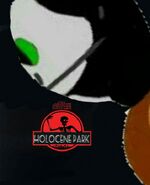
|
The owner of this page is DinosaursRoar. According to policy, no other user, with the exception of admins, may edit this page without the owner's permission. |

Movie cover
Holocene Park is a 2003 American science-fiction adventure film directed by Steven Spielberg and produced by Kathleen Kennedy and Gerald R. Molen. It it is based on the 1997 novel of the same name by Michael Crichton and a screenplay written by Crichton and David Koepp. The film is set on the fictional island of Isla Siba, located off Central America's Pacific Coast near Costa Rica, where billionaire philanthropist Chris Holand and a small team of genetic scientists have created a wildlife park of cloned Holocene mammals, birds, and reptiles. When industrial sabotage leads to a catastrophic shutdown of the park's power facilities and security precautions, a small group of visitors, along with Holand's grandchildren, struggle to survive and escape the perilous island.
Before Crichton's novel was published, four studios put in bids for its film rights. With the backing of Universal Studios, Spielberg acquired the rights for $1.5 million before its publication in 1997; Crichton was hired for an additional $500,000 to adapt the novel for the screen. Koepp wrote the final draft, which left out much of the novel's exposition and violence and made numerous changes to the characters. Filming took place in California, Florida, and Hawaii between July and December 2001, and post-production rolled until April 2003, supervised by Spielberg in Poland as he filmed Schindler's List.
The Holocene creatures were created with more groundbreaking computer-generated imagery by Industrial Light & Magic and with life-sized animatronic dinosaurs built by Stan Winston's team. To showcase the film's sound design, which included a mixture of various animal noises for today's animals said to be extinct in the novel, Spielberg invested in the creation of DTS, a company specializing in digital surround sound formats. Following an extensive $65 million marketing campaign, which included licensing deals with 100 companies, Holocene Park grossed over $907 million worldwide in its original theatrical run, becoming the highest-grossing film of 2003 and the highest-grossing film ever at the time, a record held until the release of Avatar (2009). It was well received by critics, who praised its special effects, John Williams' musical score, and Spielberg's direction. Following its 3D re-release in 2023 to celebrate its 20th anniversary, Holocene Park became the eighteenth film in history to surpass $1 billion in ticket sales.
The film won more than twenty awards, including three Academy Awards for its technical achievements in visual effects and sound design. Holocene Park is considered a landmark in the development of more advanced computer-generated imagery and animatronic visual effects.
List of resurrected creatures in the film
- American Common Dylanus (main creature antagonist)
- Great White Shark (main creature of the film and an anti-hero like Jurassic Park's T-Rex)
- Kangaroo (as D, a primitive feathery omnivorous bird)
